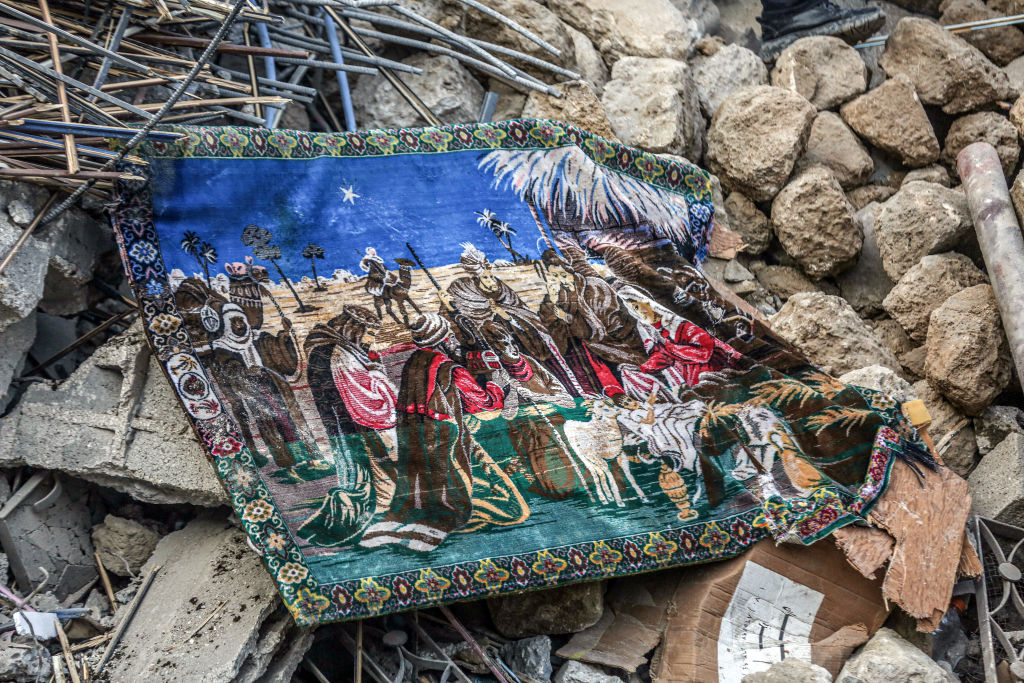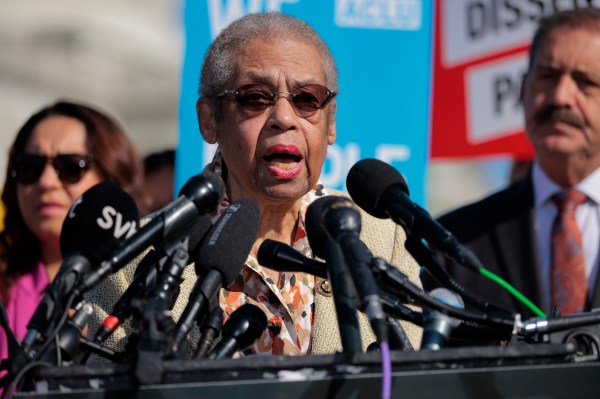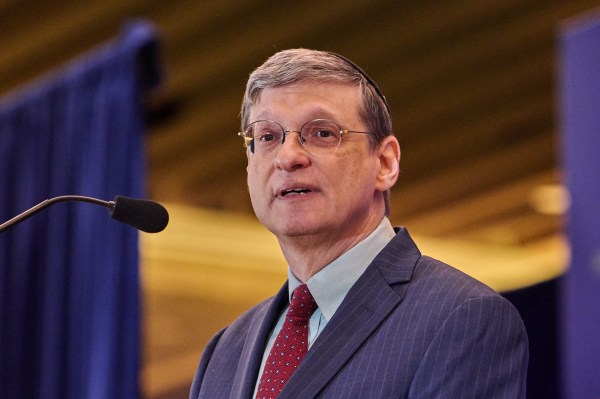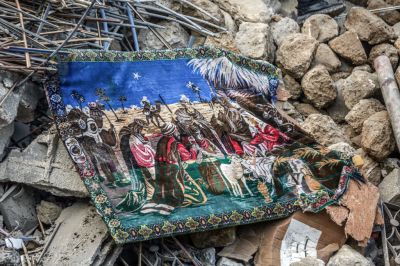The people huddling for safety in the compound of St. Porphyrios Orthodox Church in Gaza City may seem radically different from the rest of Gaza’s population. These 500 people represent just under half of all Christians in the Gaza Strip. Since October 7, more than 1,200 in Israel and thousands in Gaza have been killed. Many more are suffering too—including one of the oldest Christian communities in the world.
So in that way this small minority sheltering at St. Porphyrios Orthodox Church—a place that has meant everything to them and to their people for centuries—is but a part of the whole: a group whose ancestral ties to this place compels them to stay even as bombs fall from overhead (the church was hit by was hit by an Israeli airstrike last month) and battles rage on the ground.
The roots that tie these people here seem especially important at this time of year, as Christmas approaches. The story of the gospel began in Palestine, after all: the birth of the Christ child, away in a manger—in Palestine—while shepherds watched their flocks—in Palestine. The roots of the Christians in Gaza run so deep that even at the outbreak of this war, as they have the last three wars, many said they would not leave the place where they were born and baptized, the place they now have come for shelter.
For many North Americans, this is an incomprehensible stance. We move about our country freely, as climate, economics, or whim dictate. According to data compiled in September, Americans live in their homes an average of eight years before selling and moving on. Our homes are built with a life expectancy of less than 100 years, our household goods temporary things with built-in obsolescence. Most of us have no relation to the people who built our homes, offices, or places of worship.
For the people in Gaza of all faiths, what is incomprehensible is this lack of permanence. They live on the land their ancestors lived on, produce many of the same crops their ancestors did, and offer worship in the same structures their ancestors built. One of these ancient buildings, the Church of St. Porphyrios is, at almost 1,600 years old, older than most modern countries. Archbishop Alexios of Tiberias of the Patriarchate of Jerusalem, the local bishop and rector of the church, calls St. Porphyrios Orthodox Church a treasure of Christianity, but it is more than that; it is a treasure of humanity and archaeology with a history more profound and robust than that of most current countries.
The current church complex is not the original structure built in 420 A.D. Almost nothing of that remains. It was not a building constructed by a faceless architectural firm, submitting blueprints to a planning department, obtaining permits, and hiring contractors who in turn hired subcontractors. The original church building was built by the roughly 280 Christians in Gaza at the time—by hand. Between whatever their normal labor was, with funds they gave from sacrificing their daily necessities, with bricks they made and stones they gathered, according to the plans they drew up under their ecclesiastical hierarch, Archbishop Porphyrios of Gaza, who is the direct predecessor of Archbishop Alexios of Tiberias.
What is known of Gaza in those days is that the pagan majority of the time was hostile enough to the minority Christian population that the church had to be built outside the city walls. The Christian minority was, even then, so marginalized that the bishops were styled as “bishops about Gaza” rather than “bishops of Gaza.” These experiences, and the memories of the saints who lived among their people, were built into the very bricks of the church. For them, the events of Christ’s incarnation and resurrection were still closely held in their hearts. Consider what we know of our own history. Americans can tell what their ancestors did 400 years ago with great pride. Was an ancestor a passenger on the Mayflower? Was one among the Native Americans without whom the earliest colonists would not have survived their first winter? A patriot who served in the Revolutionary War more than 100 years later?
We know what our forefathers were doing, how they lived, what they ate, and how they worshiped. The people of Palestine had these memories of their ancestors as well. The early Christians who built the first church at the current site of St. Porphyrios remembered the names we know as people of the Bible, but they remembered them as their ancestors, people who walked the same streets they did. Christ himself walked in their villages, as did his disciples. They shared these ancestral memories as they built their temple with their own hands.
Six hundred years after the first structure, the next structure at the site was consecrated in 1050 A.D., and the temple was renamed to honor St. Porphyrios, who is buried in the northeast corner of the current church. The church’s present-day structure is the result of renovations in 1856. Tiny by modern standards, only 75 feet long by 29 feet wide, St. Porphyrios is the third oldest church still active in the world and the oldest in Gaza. This church formed the memories of generations who looked back and saw not only their own ancestors, but the memory of those whose names are in the Bible.
Those who know the Bible know those names well. We sing of places in the Holy Land and events that occurred there more than 2,000 years ago. We remember that Palestine includes not only Gaza, but the West Bank. We can read of Jesus as he traveled around Palestine, read the name of His friend Lazarus, whose tomb is a mere 50 miles from St. Porphyrios. Hundreds of people stood at the tomb with Lazarus’ sisters, Mary and Martha, and hundreds of Palestinian people witnessed the many miracles of Jesus, believed, and handed that belief down to their children, saying: “Here, our Lord walked. Our fathers were there. Remember.”
Palestinian Christians remember, and during times of peace pray in these places with hundreds of people from all over the world who come to worship their God in the place where he lived his life. Today, they huddle daily in the church to pray for peace and to get safely through the day or night. At least twice a day, every day, they gather to pray and worship. Today, it is not safe for them to walk the same streets their ancestors walked with the God they worship morning and night.
The Orthodox Christians of Gaza have only St. Porphyrios Church, the Arab Orthodox Community Center, and the Arab Orthodox School, also hit by blasts. They are both sheltering and worshiping in the church—and getting other physical needs met there, at the church. Of course other Christian communities call Gaza home: the Holy Family Catholic Church and Gaza Baptist Church are also sheltering Gazans—Christians and non-Christians alike—and sometimes are so full the refugees sleep on the steps outside the building.
The West Bank—where most Christian holy sites are located—is now cut off from Gaza.The monasteries carved into the cliffs around the West Bank, more than 1,000 years old, remind people that not only Muslims and Jews live here, but for centuries, Christians have as well. They still do, even under control of Hamas and a siege from Israel. They pray they can go on living the faith of their fathers in a war-torn land.






Please note that we at The Dispatch hold ourselves, our work, and our commenters to a higher standard than other places on the internet. We welcome comments that foster genuine debate or discussion—including comments critical of us or our work—but responses that include ad hominem attacks on fellow Dispatch members or are intended to stoke fear and anger may be moderated.
With your membership, you only have the ability to comment on The Morning Dispatch articles. Consider upgrading to join the conversation everywhere.